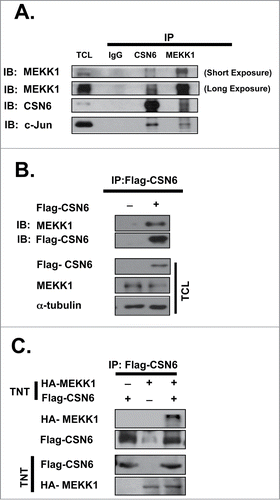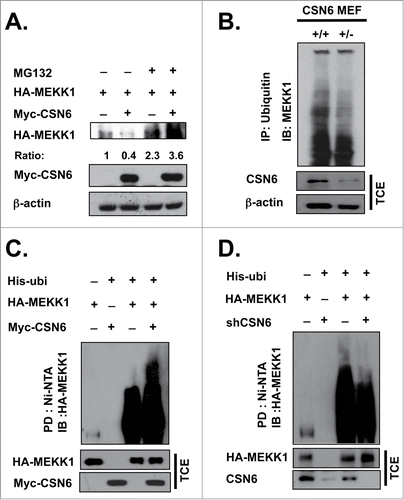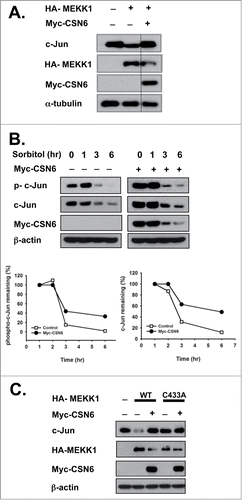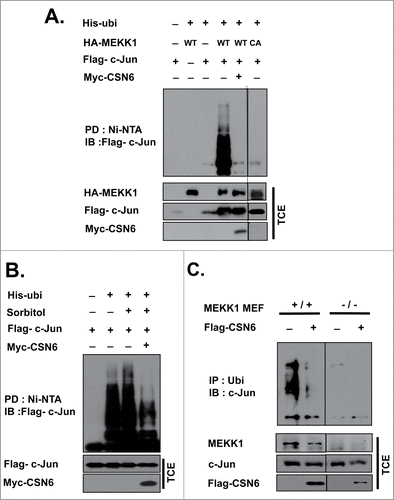Figures & data
Figure 1. In vivo and in vitro binding between CSN6 and MEKK1. (A) Endogenous CSN6 interacts with MEKK1. HEK 293T cells were lysed and subjected to immunoprecipitation with IgG-, CSN6-, and MEKK1-specific antibodies. Both immunoprecipitation and total cell lysate (TCL) were immunoblotted with the indicated antibodies. (B) Exogenous CSN6 interacts with endogenous MEKK1. HEK 293T cells were transfected with Flag-CSN6 plasmid and then subjected to immunoprecipitation (anti-Flag) and Western blot analysis with MEKK1 antibody. (C) CSN6 binds with MEKK1 in vitro. Flag-CSN6 and HA-MEKK1 proteins were created using an in vitro transcription/translation system (TNT). Proteins were immunoprecipitated with M2 Flag beads and subjected to an SDS-PAGE analysis. (A, B) All cells were treated with 10 μM MG132 for 6 hrs before being harvested.

Figure 2. CSN6 negatively regulates MEKK1 steady-state expression. (A) Overexpression of CSN6 downregulates MEKK1 levels. HEK293T cells were co-transfected with Myc-CSN6 and HA-MEKK1 plasmid. A Western blot analysis was performed with the same amount of cell lysate. (B) MEKK1 was stabilized under CSN6 knockdown conditions. HEK293T cells were co-transfected with shCSN6 and HA-MEKK1 plasmid and then subjected to immunoblotting with the indicated antibodies. (C) Full-length CSN6 decreased MEKK1 expression. Cells were co-transfected with Flag-WT CSN6 or the truncated form of CSN6 (N terminal or C-terminal) and HA-MEKK1 plasmid. Cell lysates were immunoblotted with the indicated antibodies. (D) Overexpression of CSN6 increased the turnover rate of MEKK1. Myc-CSN6- and HA-MEKK1-co-transfected HEK 293T cells were treated with CHX for the indicated times and then subjected to Western blot analysis. The density of MEKK1 was measured, and the integrated optical density (IOD) was measured. The turnover of MEKK1 was indicated graphically. (E) Knockdown of CSN6 decreased the turnover rate of MEKK1. shCSN6 and HA-MEKK1-co-transfected HEK 293T cells were treated with CHX for the indicated times and then subjected to immunoblotting analysis. The density of MEKK1 was measured, and the integrated optical density (IOD) was measured. The turnover of MEKK1 was indicated graphically.

Figure 3. CSN6 induces MEKK1 ubiquitination. (A) HEK293T cells were co-transfected with Myc-CSN6 and HA-MEKK1 plasmid for 48 hrs and then treated with DMSO or MG132 for 6 hrs before being harvested. A Western blot analysis was performed using the same amount of cell lysate. (B) Loss of CSN6 decreased MEKK1 ubiquitination levels. csn6+/+ and csn6+/− MEFs were lysed and subjected to immunoprecipitation with ubiquitin antibody and then immunoblotted with MEKK1 antibody. (C, D) CSN6 efficiently ubiquitinates MEKK1. HEK 293T cells were co-transfected with the indicated plasmids, followed by nickel bead purification for an in vivo ubiquitination assay. An immunoblot analysis was performed. (B-D) All cells were treated with 10 μM MG132 for 6 hrs before being harvested.

Figure 4. CSN6 rescues MEKK1-mediated c-Jun destabilization. (A) CSN6 inhibits c-Jun destabilization by MEKK1. HEK293T cells were co-transfected with the indicated plasmids, and an immunoblot analysis was performed with c-Jun antibody. (B) CSN6 rescues osmotic stress-induced c-Jun degradation. Cells were transfected with Myc-CSN6 and then treated with 500 mM sorbitol for the indicated times. A Western blot analysis was performed with the same amount of cell lysates. The density of phospho-c-Jun or MEKK1 was measured, and the integrated optical density (IOD) was measured. The turnover of phospho-c-Jun or MEKK1 was indicated graphically. (C) CSN6 hampered WT MEKK1-induced c-Jun degradation. Cells were co-transfected with HA-WT or the PHD/RING finger domain mutant form of MEKK1 (C433A) and Myc-CSN6 and then subjected to immunoblotting with c-Jun antibody.

Figure 5. CSN6 inhibits MEKK1-mediated c-Jun ubiquitination. (A) HEK 293T cells were transfected with the expression vector for His-ubi, Flag-c-Jun, HA-MEKK1, and Myc-CSN6, followed by nickel bead purification and a Western blot analysis. (B) HEK 293T cells were co-transfected with the indicated expression vectors and then treated with 500 mM sorbitol for 6 hrs before being harvested. Lysates were subjected to nickel bead purification for an in vivo ubiquitination assay. (C) MEKK1+/+ and MEKK1−/− MEFs were transfected with Flag-CSN6, lysed and subjected to immunoprecipitation with ubiquitin antibody, and then immunoblotted with c-Jun antibody. All cells were treated with 10 μM MG132 for 6 hrs before being harvested.

Figure 6. CSN6 regulates the c-Jun target gene through MEKK1. (A) An enrichment score graph and ranked list metric graph show the upregulation of c-Jun target genes in breast cancer patients with high CSN6 and low MEKK1 expression. (B) Kaplan-Meier survival curves of overall survival duration based on MEKK1 and CSN6 expression in gene expression profiles of breast cancer patient cohort GSE20194. Data were downloaded from the Gene Expression Omnibus database and matched with corresponding clinical data in analysis. Log-rank analysis was used to test for significance. P = 0.04 and 0.028 respectively. (C) Model of CSN6-MEKK1-c-Jun axis in regulating c-Jun transcriptional activity.

